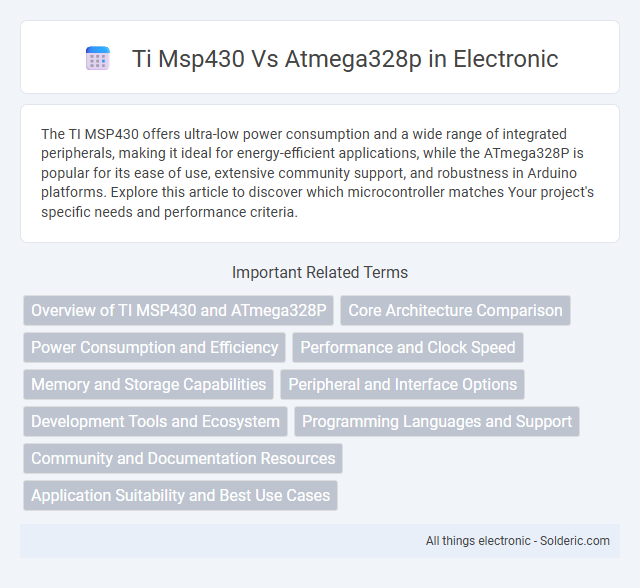The TI MSP430 offers ultra-low power consumption and a wide range of integrated peripherals, making it ideal for energy-efficient applications, while the ATmega328P is popular for its ease of use, extensive community support, and robustness in Arduino platforms. Explore this article to discover which microcontroller matches Your project's specific needs and performance criteria.
Comparison Table
| Feature | TI MSP430 | Atmega328P |
|---|---|---|
| Processor Core | 16-bit RISC | 8-bit AVR |
| Max Clock Speed | 16 MHz | 20 MHz |
| Flash Memory | Up to 512 KB | 32 KB |
| RAM | Up to 66 KB | 2 KB |
| Operating Voltage | 1.8 V - 3.6 V | 1.8 V - 5.5 V |
| Power Consumption | Ultra-low power (as low as 0.3 uA in standby) | Low power (typically 0.2 mA active) |
| ADC Resolution | 12-bit SAR ADC | 10-bit ADC |
| I/O Pins | Varies (commonly 16-64) | 23 I/O pins |
| Communication Interfaces | UART, SPI, I2C | UART, SPI, I2C |
| Typical Applications | Low-power embedded systems, wearable devices, sensors | Arduino boards, hobbyist projects, basic embedded systems |
Overview of TI MSP430 and ATmega328P
TI MSP430 is a ultra-low-power microcontroller family designed for energy-efficient applications, featuring a 16-bit RISC CPU optimized for low power consumption and fast wake-up times. ATmega328P, an 8-bit AVR microcontroller by Atmel (now Microchip), is widely used in embedded systems and Arduino platforms due to its balance of performance, ease of use, and extensive I/O capabilities. Your choice between the TI MSP430 and ATmega328P depends on specific needs such as power efficiency versus processing simplicity and ecosystem support.
Core Architecture Comparison
The TI MSP430 utilizes a 16-bit RISC architecture designed for low power consumption and efficient instruction execution, making it ideal for battery-operated devices. In contrast, the Atmega328P features an 8-bit AVR architecture with a rich instruction set optimized for ease of programming and rapid development. Your choice depends on whether you need ultra-low power performance or a widely supported platform with extensive community resources.
Power Consumption and Efficiency
The TI MSP430 microcontroller is renowned for its ultra-low power consumption, often operating in deep sleep modes with currents as low as 0.5 uA, making it highly efficient for battery-powered applications. In contrast, the Atmega328P typically consumes higher currents, around 0.1 mA in sleep mode, which can impact battery life in energy-sensitive designs. The MSP430's advanced low-power modes and efficient clock system provide superior energy efficiency compared to the Atmega328P, making it ideal for applications requiring extended operation on minimal power sources.
Performance and Clock Speed
The TI MSP430 offers ultra-low power consumption with clock speeds ranging from 1 MHz to 25 MHz, making it ideal for battery-powered applications requiring long runtimes. In comparison, the ATmega328P operates at up to 20 MHz, delivering solid performance suitable for general-purpose embedded systems and hobbyist projects. Your choice depends on whether you prioritize energy efficiency or slightly higher clock speed for processing tasks.
Memory and Storage Capabilities
The TI MSP430 offers up to 512KB of flash memory and 66KB of RAM, optimized for low-power applications requiring efficient data storage and quick access. The ATmega328P includes 32KB of flash memory and 2KB of SRAM, making it suitable for simpler projects with moderate memory needs. Your choice depends on whether you require extensive memory for complex programs or prefer the ATmega328P's balance of storage and cost-effectiveness.
Peripheral and Interface Options
The TI MSP430 features diverse peripheral options including multiple UARTs, SPI, I2C, and 12-bit ADCs with sampling timers, ideal for low-power sensor applications. The Atmega328P offers UART, SPI, and I2C communication interfaces, along with 10-bit ADC and PWM outputs suitable for general-purpose embedded systems. MSP430 supports advanced analog modules like comparators and operational amplifiers, while Atmega328P integrates versatile timers and watchdog functionality.
Development Tools and Ecosystem
The TI MSP430 offers a comprehensive ecosystem with Code Composer Studio and Energia IDE, supporting extensive libraries and real-time debugging features that cater to low-power applications. The Atmega328P benefits from a vast Arduino community and toolchain, including the Arduino IDE and Atmel Studio, enabling straightforward programming and widespread third-party libraries. Both microcontrollers provide robust support, but the Atmega328P excels in ease of use and community resources, while the MSP430 emphasizes precision and power efficiency in its development tools.
Programming Languages and Support
The TI MSP430 supports programming primarily in C and assembly, with robust development environments like Code Composer Studio offering extensive debugging and optimization tools tailored for low-power applications. The Atmega328P benefits from a wide range of programming languages including C and C++, with Arduino IDE providing an accessible platform and vast community support that simplifies code development and deployment. Both microcontrollers enjoy strong ecosystem support, but Atmega328P's integration with Arduino makes it particularly popular in rapid prototyping and educational projects.
Community and Documentation Resources
The TI MSP430 benefits from extensive documentation directly from Texas Instruments, including detailed datasheets and application notes, paired with a specialized community on forums like E2E and MSP430 LaunchPad. The Atmega328P enjoys a broader global user base due to Arduino's popularity, providing abundant tutorials, libraries, and an active community on platforms like the Arduino Forum and GitHub, which accelerates project development. Both microcontrollers have strong support, but Atmega328P's ecosystem often offers more third-party resources and beginner-friendly materials.
Application Suitability and Best Use Cases
The TI MSP430 excels in low-power, battery-operated applications such as wearable devices, sensor networks, and portable medical instruments due to its ultra-low power consumption and integrated analog peripherals. The ATmega328P is highly suitable for general-purpose embedded systems, educational projects, and hobbyist development owing to its ease of use, abundant community support, and compatibility with Arduino platforms. Choosing between the two depends on specific application requirements, where MSP430 is preferred for energy-efficient tasks and ATmega328P for versatile, cost-effective prototyping.
ti msp430 vs atmega328p Infographic

 solderic.com
solderic.com